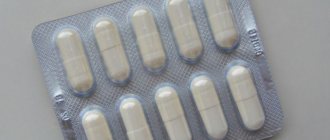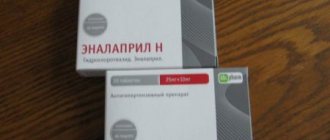Release form and composition
Dosage forms:
- Dividable tablets: from white with a creamy tint to white, round in shape with a chamfer on both sides, a bevel from the edges to the break line on one side and engraving: above the dividing line - a heart-shaped symbol, under the line - the number 200 (10 each pcs in blisters, 3 blisters in a cardboard pack);
- Solution for intravenous (IV) administration: transparent liquid of light yellow color (3 ml in ampoules, 6 pcs in a box).
Active ingredient: amiodarone hydrochloride:
- 1 tablet – 200 mg;
- 1 ml of solution – 50 mg.
Auxiliary components:
- Tablets: corn starch, lactose monohydrate, magnesium stearate, colloidal anhydrous silicon dioxide, povidone K90F;
- Solution: benzyl alcohol, polysorbate 80, water for injection.
Cordarone price, where to buy
The price of Cordarone in 200 mg tablets is 320 rubles per pack of 30 pieces.
- Online pharmacies in RussiaRussia
- Online pharmacies in UkraineUkraine
- Online pharmacies in KazakhstanKazakhstan
LuxPharma* special offer
- Cordarone tab.
200 mg No. 30 1700 rub. order
ZdravCity
- Cordarone tablets 200 mg 30 pcs.Chinoin
RUB 197 order
Pharmacy Dialogue
- Cordarone (200 mg tablet No. 30)Chinoin
RUB 208 order
show more
Pharmacy24
- Cordarone 200 mg No. 30 tablets Quinoin Pharmaceutical and Chemical Products Plant Private Co. Ltd., Ugorshchina
204 UAH.order - Cordarone 150 mg 50 mg/ml 3 ml No. 6 injection solution Sanofi Vinthrop Industries, France
219 UAH. order
PaniPharmacy
- Cordarone ampoule Cordarone solution d/in. 150mg amp. 3ml No. 6 France, Sanofi Winthrop Industrie
225 UAH order
- Cordarone tablets Cordarone tablets. 200 mg No. 30 France, Sanofi Winthrop Industrie
206 UAH order
show more
Indications for use
The use of Cordarone in tablet form is indicated for the prevention of relapses:
- Supraventricular paroxysmal tachycardia: attacks of recurrent sustained supraventricular paroxysmal tachycardia, recorded in patients with organic heart disease; attacks of recurrent sustained supraventricular paroxysmal tachycardia recorded in patients without organic heart disease (with the ineffectiveness of antiarrhythmic drugs of other classes or contraindications to their use); attacks of recurrent sustained supraventricular paroxysmal tachycardia recorded in patients with Wolff-Parkinson-White syndrome;
- Ventricular arrhythmias that pose a threat to the patient’s life, including ventricular tachycardia and ventricular fibrillation (during inpatient treatment with careful cardiac monitoring);
- Atrial fibrillation (atrial fibrillation) and atrial flutter.
In addition, tablets are prescribed for the treatment of patients with rhythm disturbances due to impaired left ventricular function and/or coronary heart disease (CHD).
The tablets are taken to prevent sudden arrhythmic death in patients who have recently suffered a myocardial infarction, have clinical manifestations of chronic heart failure or more than 10 ventricular extrasystoles in 1 hour and a reduced left ventricular ejection fraction (less than 40%).
The use of the drug in the form of a solution is indicated for the relief of attacks of ventricular paroxysmal tachycardia, supraventricular paroxysmal tachycardia with a high frequency of ventricular contractions (especially in Wolff-Parkinson-White syndrome), persistent and paroxysmal forms of atrial fibrillation (atrial fibrillation) and atrial flutter.
Cordarone injections are also used for cardiac resuscitation in case of cardiac arrest, against the background of ventricular fibrillation, resistant to defibrillation.
Overdose of the drug Cordarone, symptoms and treatment
Information regarding overdose of Cordarone is limited. In some cases, sinus bradycardia, ventricular arrhythmia, torsade de pointes tachycardia, liver damage, and vascular insufficiency were observed. Considering the pharmacokinetic profile of the drug, it is recommended to monitor the patient’s condition over a long period of time (especially monitoring of cardiac activity). Treatment is symptomatic. Neither Cordarone nor its metabolites are removed by dialysis.
Contraindications
Contraindications to the use of tablets and solution:
- Age up to 18 years;
- Atrioventricular (AV) block of II and III degrees, two- and three-fascicle blocks in patients without a pacemaker;
- Sick sinus syndrome (sinoatrial block, sinus bradycardia), except in cases of correction with an artificial pacemaker (pacemaker);
- Concomitant use with drugs that prolong the QT interval and cause the development of paroxysmal tachycardia, including ventricular “pirouette” tachycardia: class IA antiarrhythmic drugs (hydroquinidine, quinidine, procainamide, disopyramide) and class III (bretylium tosylate, ibutilide, dofetilide), sotalol; other non-antiarrhythmic drugs: vincamine, bepridil, phenothiazines (fluphenazine, cyamemazine, chlorpromazine, levomepromazine, trifluoperazine, thioridazine), benzamides (sultopride, amisulpride, sulpride, veraliprid, tiapride), pimozide, butyrophenones (haloperidol, droperidol), sertindole, cisapride, tricyclic antidepressants, azoles, macrolide antibiotics (including spiramycin, erythromycin when administered intravenously), antimalarials (chloroquine, halofantrine, quinine, mefloquine), difemanil methyl sulfate, pentamidine only when administered parenterally, mizolastine, fluoroquinolones, astemizole and terfenadine;
- Hypomagnesemia, hypokalemia;
- Prolongation of the QT interval, including congenital;
- Pregnancy and breastfeeding period;
- Thyroid dysfunction (hyperthyroidism, hypothyroidism);
- Hypersensitivity to the components of the drug and to iodine.
Cordarone should be prescribed with caution to patients with first degree AV block, arterial hypotension, severe chronic (III-IV functional class according to the NYHA classification) or decompensated heart failure, liver failure, bronchial asthma, severe respiratory failure and elderly patients.
The tablets should not be taken if you have interstitial lung disease.
Additional contraindications to the use of the solution:
- Severe arterial hypotension, cardiogenic shock, collapse;
- Intraventricular conduction disorders (two- and three-fascicle blockades) in the absence of a permanent pacemaker;
- Heart failure, arterial hypotension, cardiomyopathy or severe respiratory failure - for intravenous bolus administration.
All of these contraindications should not be taken into account when performing cardiac resuscitation in case of cardiac arrest due to ventricular fibrillation, resistant to cardioversion.
The use of amiodarone in pregnant women is possible for ventricular cardiac arrhythmias that pose a threat to the life of the mother, if the expected clinical effect outweighs the potential risk and danger to the fetus.
Drug interactions Cordarone
The simultaneous use of Cordarone with drugs that can cause paroxysmal ventricular tachycardia of the torsade de pointes type is contraindicated:
- class Ia antiarrhythmic drugs (quinidine, hydroquinidine, disopyramide);
- class III antiarrhythmic drugs (sotalol, dofetilide, ibutilide);
- bepridil, cisapride, difemanil, erythromycin for intravenous administration, mizolastine, sparfloxacin, vincamine for intravenous administration;
- sultopride.
There is an increased risk of developing ventricular arrhythmias, especially paroxysmal tachycardia of the torsade de pointes type, when used simultaneously with sparfloxacin due to prolongation of the QT on the ECG (additive electrophysiological effect). Combination therapy with the following drugs is not recommended:
- neuroleptics that can cause paroxysmal tachycardia of the torsade de pointes type, some phenothiazine neuroleptics (chlorpromazine, cyamemazine, levomepromazine, thioridazine, trifluoperazine), benzamides (amisulpride, sulpiride, tiapride), butyrophenones (droperidol, haloperidol), pimozide (increased risk of developing ventricular aritis miy, especially paroxysmal tachycardia such as torsade de pointes);
- halofantrine, moxifloxacin, pentamidine (increased risk of developing ventricular arrhythmias, especially paroxysmal tachycardia of the torsade de pointes type. If such a combination is unavoidable, preliminary monitoring of the QT and constant ECG monitoring in the future are necessary);
- injectable form of diltiazem (risk of developing bradycardia and AV block. If such a combination is necessary, careful monitoring of the patient's condition and constant ECG monitoring are required);
- β-adrenergic receptor blockers, except sotalol and esmolol (risk of impaired automaticity, conduction and contractility of the heart due to suppression of sympathetic compensatory mechanisms).
The following drugs should be prescribed with caution in combination with Cordarone: Oral anticoagulants. Due to the increased effect of oral anticoagulants and the increased risk of bleeding, it is necessary to more often monitor the level of prothrombin in the blood and adjust the dose of oral anticoagulants during treatment with Cordarone and after discontinuation of the drug. Cyclosporine. There may be an increase in the level of cyclosporine in the blood plasma, associated with a decrease in its metabolism in the liver, which increases the nephrotoxicity of the drug. In this case, dose adjustment is necessary. Oral forms of diltiazem. Risk of developing bradycardia and AV block, especially in elderly patients. Clinical and ECG monitoring is required. Foxglove preparations . There may be a violation of automaticity (severe bradycardia) and AV conduction. It is possible to increase the concentration of digoxin in the blood plasma (due to a decrease in its clearance). It is necessary to carry out ECG studies, clinical and biochemical monitoring (including, if necessary, determination of the level of digoxin in the blood plasma); It may be necessary to change the dose of cardiac glycosides. Esmolol. There may be a violation of the automaticity, conductivity and contractility of the heart (suppression of sympathetic compensatory mechanisms). Clinical and cardiographic monitoring of the patient's condition is necessary. Drugs that can cause hypokalemia:
- diuretics that cause hypokalemia on their own or in combination with other drugs;
- stimulant laxatives;
- systemic corticosteroids (gluco-, mineralo-), tetracosactide;
- amphotericin B (iv use).
Increased risk of developing ventricular arrhythmias, especially paroxysmal tachycardia such as torsade de pointes (hypokalemia is a predisposing factor). Clinical and cardiographic monitoring of the patient’s condition and monitoring of serum potassium levels are recommended. Phenytoin. It is possible to increase the level of phenytoin in the blood plasma with symptoms of overdose (in particular of a neurological nature). Clinical monitoring and dose reduction of phenytoin is necessary if signs of overdose occur; if possible, determine the level of phenytoin in the blood plasma. Drugs that cause bradycardia. Calcium channel blockers (diltiazem, verapamil), β-adrenergic receptor blockers (except sotalol), clonidine, guanfacine, digitalis preparations, mefloquine, cholinesterase inhibitors (donepezil, galantamine, rivastigmine, tacrine, ambemonium, pyridostigmine, neostigmine). Increased risk of developing ventricular arrhythmias, especially paroxysmal tachycardia such as torsade de pointes. Clinical and ECG monitoring is recommended. Simvastatin. Dose-dependent increase in the risk of side effects such as rhabdomyolysis (decreased metabolism of simvastatin in the liver). The dose of simvastatin should not exceed 20 mg per day. If a therapeutic effect cannot be achieved when used at such a dose, it is necessary to prescribe another statin that does not interact with Cordarone. Anesthetic agents. Potentially serious complications may occur in patients undergoing general anesthesia: bradycardia not corrected by atropine, hypotension, conduction disturbances, decreased cardiac output. Very rarely - severe respiratory complications, sometimes resulting in death (acute adult respiratory distress syndrome). Typically, they are observed immediately after surgery, possibly due to incompatibility with high oxygen concentrations.
Directions for use and dosage
- Tablets: orally, before meals, with a small amount of water. The dosage is prescribed by the doctor based on clinical indications and the patient’s condition. The loading dose in a hospital setting is increased, starting with a daily dose of 0.6-0.8 g (up to 1.2 g) divided into several doses, until a total dose of 10 g is reached after 5-8 days of administration; Outpatient saturation up to 10 g is carried out over 10-14 days at a daily dose of 0.6-0.8 g. The maintenance dose should be the minimum effective, selected individually, can range from 0.1 to 0.4 g per day. The average therapeutic single dose is 0.2 g, daily dose is 0.4 g. The maximum single dose is 0.4 g, daily dose is 1.2 g. Tablets can be taken every other day or with a break 2 days a week;
- Solution for injection: intended for intravenous administration to achieve a rapid antiarrhythmic effect or when it is impossible to take the drug orally. In addition to special emergency clinical situations, the solution should be used only in intensive care hospital conditions under constant monitoring of blood pressure and electrocardiogram (ECG). The solution should not be mixed with other agents, administered into the same infusion line, or used undiluted. For dilution, it is necessary to use only a 5% dextrose (glucose) solution; the concentration of the resulting solution should be no less than when diluting 6 ml of the drug in 500 ml of 5% dextrose (glucose). Administration should always be done through a central venous catheter; administration through peripheral veins is allowed for cardiac resuscitation in ventricular fibrillation resistant to cardioversion in the absence of central venous access. In case of severe cardiac arrhythmias, if it is impossible to take the drug orally, intravenous drip administration through a central venous catheter is recommended at the usual loading dose at the rate of 0.005 g per 1 kg of patient weight in 250 ml of a 5% dextrose (glucose) solution. It should be administered over 20-120 minutes, preferably using an electronic pump. It can be administered 2-3 times within 24 hours; adjustment of the rate of administration depends on the clinical effect. The maintenance daily dose of amiodarone is usually prescribed in the amount of 0.6-0.8 g, which can be increased to 1.2 g in 250 ml of a 5% dextrose (glucose) solution. Over the course of 2-3 days of intravenous administration, you should gradually switch to taking the drug orally. Intravenous jet administration during cardiac resuscitation during cardiac arrest due to ventricular fibrillation, resistant to cardioversion, is recommended at a dose of 0.3 g of the drug diluted in 20 ml of a 5% dextrose (glucose) solution. If there is no clinical effect, additional administration of 0.15 g of amiodarone is possible.
Side effects
The use of Cordarone can cause side effects common to each form:
- From the respiratory system: very rarely - bronchospasm and/or apnea due to severe respiratory failure, especially bronchial asthma; acute respiratory distress syndrome (sometimes immediately after surgery, sometimes fatal);
- From the cardiovascular system: often – moderate (dose-dependent) bradycardia; very rarely - severe bradycardia or sinus node arrest (in exceptional cases), more often in patients with sinus node dysfunction and elderly patients;
- From the nervous system: very rarely - headache, benign intracranial hypertension.
The use of tablets can cause the following side effects:
- From the cardiovascular system: infrequently - AV block of varying degrees, sinoatrial block (conduction disturbance), the emergence of new or aggravation of existing arrhythmias; frequency unknown – progression of chronic heart failure (during long-term therapy);
- From the respiratory system: often - cases of alveolar or interstitial pneumonitis, bronchiolitis obliterans with pneumonia (sometimes fatal), pleurisy, pulmonary fibrosis, severe shortness of breath or dry cough with symptoms of deterioration in general condition (fatigue, weight loss, increased body temperature ) or without it; frequency unknown - pulmonary hemorrhage;
- From the digestive system: very often - nausea, vomiting, loss of appetite, decreased sense of taste or loss thereof, a feeling of heaviness in the epigastrium (especially at the beginning of use, it goes away after reducing the dose), isolated spasmodic disturbance of the activity of liver enzymes in the blood serum; often - jaundice, acute liver damage, liver failure (sometimes fatal); very rarely - chronic liver diseases such as cirrhosis, pseudoalcoholic hepatitis (sometimes fatal);
- From the senses: very often - transient visual impairment (blurred contours in bright light) caused by the deposition of complex lipids in the corneal epithelium; very rarely – optic neuritis or optic neuropathy;
- From the skin: very often – photosensitivity; often – transient skin pigmentation (with long-term therapy); very rarely - erythema, skin rash, alopecia, exfoliative dermatitis (relationship with the drug has not been confirmed);
- From the nervous system: often - extrapyramidal symptoms (tremor), sleep disturbances, nightmares; rarely – myopathy and/or peripheral neuropathies (sensorimotor, mixed, motor); very rarely - cerebellar ataxia;
- Endocrine disorders: often - hypothyroidism (if the level of thyroid-stimulating hormone (TSH) in the blood serum is high, the drug must be discontinued), hyperthyroidism; very rarely - syndrome of impaired secretion of antidiuretic hormone;
- Other: very rarely - epididymitis, vasculitis, impotence (no connection with amiodarone has been confirmed), hemolytic anemia, thrombocytopenia, aplastic anemia.
The use of Cordarone in the form of a solution causes undesirable effects:
- From the cardiovascular system: often – moderate and transient decrease in blood pressure (BP); very rarely - proarrhythmogenic effect, progression of heart failure, flushing of the face (with intravenous jet administration);
- Immune system disorders: very rarely - anaphylactic shock; frequency unknown - angioedema;
- From the respiratory system: very rarely - shortness of breath, cough, interstitial pneumonitis;
- From the skin: very rarely - increased sweating, feeling hot;
- From the digestive system: very often – nausea; very rarely - increased or decreased activity of liver enzymes in the blood (isolated), acute liver damage (sometimes fatal);
- Reactions at the injection site: often - pain, swelling, induration, erythema, necrosis, infiltration, extravasation, inflammation, phlebitis (including superficial), thrombophlebitis, cellulitis, pigmentation, infection.
Pharmacodynamics and pharmacokinetics
The main substance is amiodarone . It has coronary dilation, antianginal, hypotensive, alpha-adrenergic blocking, beta-adrenergic blocking effects. Under the influence of the drug, the oxygen demand of the heart muscle decreases, which explains the antianginal effect . Cordarone inhibits the functioning of alpha and beta adrenergic receptors of the cardiovascular system without blocking them.
Amiodarone reduces the sensitivity of the sympathetic nervous system to hyperstimulation, reduces the tone of the coronary arteries, improves blood flow, slows down the pulse, increases the energy reserves of the myocardium, and lowers blood pressure.
The antiarrhythmic effect is achieved by influencing the course of electrophysiological processes in the myocardium, lengthening the action potential of myocardiocytes, increasing the refractory, effective period of the atria, His bundle, AV node, and ventricles.
Cordarone is able to inhibit diastolic, slow depolarization of the cell membrane of the sinus node, inhibit atrioventricular conduction, and cause bradycardia . The structure of the main component of the drug is similar to thyroid hormone.
special instructions
The drug should be taken only as prescribed by a doctor!
Side effects of Cordarone are dose-dependent, so treatment should be carried out in minimal effective doses.
During the period of use of the drug, patients should avoid exposure to direct sunlight.
The prescription of the drug should be made taking into account the data of an ECG and blood test to determine the potassium content. Correction of hypokalemia must occur before starting treatment. Treatment should be accompanied by regular monitoring of ECG (once every 3 months) and liver function indicators.
Patients with and without thyroid disease should undergo laboratory and clinical examinations of the thyroid gland before starting amiodarone therapy, during treatment, and for several months after discontinuation of the drug.
If functional disorders are suspected, it is necessary to determine the level of TSH in the blood serum.
The iodine content in the drug does not affect the reliability of determining the level of TSH, T3 and T4 hormones in the blood plasma, but can distort the results of a radioisotope study of the thyroid gland.
During the period of use of the drug, patients should undergo X-ray examination of the lungs and pulmonary function tests every 6 months.
During long-term therapy of patients with a pacemaker or implanted defibrillator, it is necessary to regularly monitor their correct functioning.
When first degree AV block appears, it is necessary to intensify monitoring. In case of development of sinoatrial block, AV block of II and III degrees, or double-bundle intraventricular block, treatment should be discontinued.
An ophthalmological examination with examination of the fundus should be performed if visual acuity decreases and blurred vision appears. In patients with optic neuritis or neuropathy that developed while taking amiodarone, further use of the drug should be discontinued.
Before the operation, you must inform the anesthesiologist about taking the drug.
Long-term therapy with Cordarone may increase the hemodynamic risk associated with anesthesia.
In addition, in rare cases, acute respiratory distress syndrome may occur in patients immediately after surgery, requiring careful monitoring during artificial ventilation.
IV jet administration should be carried out for at least 3 minutes, repeated administration is possible only 15 minutes after the first.
During the administration of the drug, the development of interstitial pneumonitis is possible, therefore, in the event of severe shortness of breath or a dry cough, with or without a deterioration in the general condition (fatigue, increased body temperature), the patient should undergo a chest x-ray. If the X-ray picture is abnormal, the drug must be discontinued, as the disease may develop pulmonary fibrosis.
It is possible to develop severe acute liver damage with the development of liver failure (sometimes fatal) during the first day of injection use; it is necessary to regularly monitor liver function during therapy.
Concomitant use with verapamil, diltiazem and beta-blockers, except esmolol and sotalol, is only possible for the prevention of life-threatening ventricular arrhythmias and restoration of cardiac activity after cardiac arrest caused by ventricular fibrillation resistant to cardioversion.
During the period of therapy, patients are advised to refrain from driving vehicles and machinery.
Pharmacological properties of the drug Cordarone
Class III antiarrhythmic agent. The mechanism of action of amiodarone is due to the blockade of ion channels of the cell membranes of cardiomyocytes (mainly potassium, to a very small extent - calcium and sodium), as well as non-competitive suppression of α- and β-adrenergic activity. As a class III antiarrhythmic agent (according to the Vaughan Williams classification), it increases the 3rd phase of the action potential. Slows down conduction in the sinoatrial, AV node and atria, especially at high heart rates. Does not change intraventricular conduction. Increases the refractory period and reduces the excitability of the myocardium of the atria, ventricles and AV node. The antianginal effect of the drug is due to a decrease in myocardial oxygen demand (due to a decrease in heart rate and a decrease in afterload) and an increase in coronary blood flow due to a direct effect on the smooth muscles of the coronary arteries. Supports cardiac output by reducing aortic pressure and peripheral vascular resistance. With intravenous administration, maximum activity is achieved after 15 minutes and lasts up to 4 hours. After oral administration, amiodarone is absorbed slowly, the pharmacokinetics are characterized by significant individual fluctuations. Amiodarone has a very large and variable volume of distribution due to extensive accumulation in various tissues (adipose tissue, heavily perfused organs such as the liver, lungs and spleen). Bioavailability when taken orally ranges from 30–80% (on average about 50%). After a single dose, the maximum concentration in the blood plasma is reached after 3–7 hours. The therapeutic effect is usually observed 1 week after the start of therapy (from several days to 2 weeks). Amiodarone has a long half-life (20–100 days). In the first days of treatment, the drug accumulates in almost all tissues, especially in adipose tissue. Elimination begins within a few days and steady-state plasma concentrations are achieved within one or several months. Taking into account the pharmacokinetics, obtaining a therapeutic effect requires the use of an initial saturating dose in order to achieve drug accumulation in tissues. 200 mg of amiodarone contains 75 mg of iodine, 6 mg of which is released as free iodine. Amiodarone is primarily excreted in bile and feces. Excretion in urine is insignificant, which allows the drug to be prescribed in normal doses to patients with renal failure. After discontinuation of the drug, its removal from the body continues for several months; It should be taken into account that after discontinuation of the drug, its effect lasts from 10 days to 1 month.






